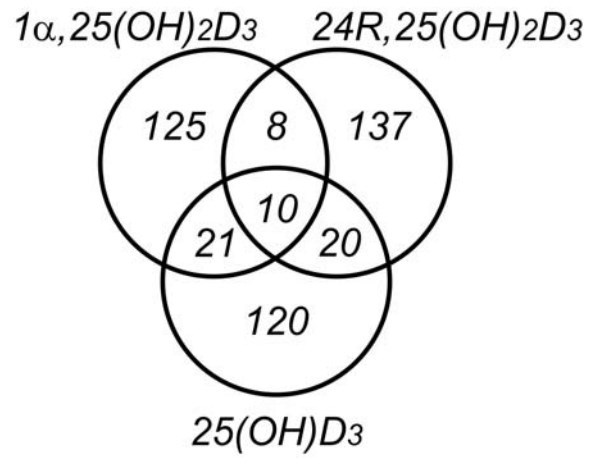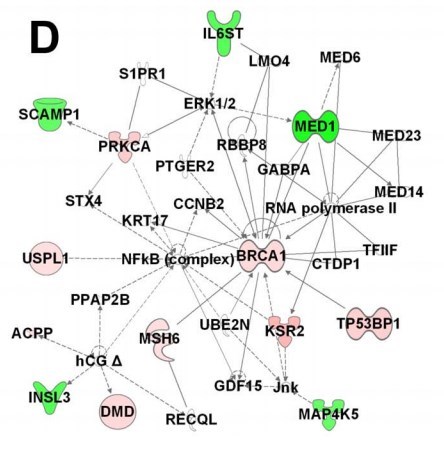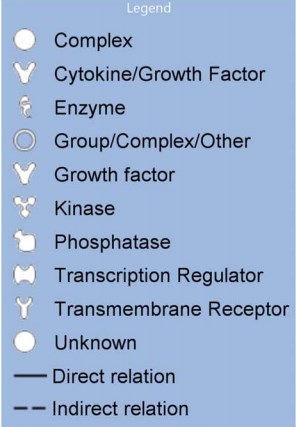Surprise:Three different types of vitamin D can activate the vitamin D receptor
Gene Expression Profiles in Human and Mouse Primary Cells Provide New Insights into the Differential Actions of Vitamin D3 Metabolites
PLoS ONE 8(10): e75338. doi:10.1371/journal.pone.0075338
Pentti Tuohimaa, Jing-Huan Wang, Sofia Khan, Marianne Kuuslahti, Kui Qian, Tommi Manninen, Petri Auvinen, Mauno Vihinen, Yan-Ru Lou mail
1α,25-Dihydroxyvitamin D3 (1α,25(OH)2D3) had earlier been regarded as the only active hormone.
The newly identified actions of 25-hydroxyvitamin D3 (25(OH)D3) and 24R,25-dihydroxyvitamin D3 (24R,25(OH)2D3) broadened the vitamin D3 endocrine system, however, the current data are fragmented and a systematic understanding is lacking. Here we performed the first systematic study of global gene expression to clarify their similarities and differences.
Three metabolites at physiologically comparable levels were utilized to treat human and mouse fibroblasts prior to DNA microarray analyses. Human primary prostate stromal P29SN cells (hP29SN), which convert 25(OH)D3 into 1α,25(OH)2D3 by 1α-hydroxylase (encoded by the gene CYP27B1), displayed regulation of 164, 171, and 175 genes by treatment with 1α,25(OH)2D3, 25(OH)D3, and 24R,25(OH)2D3, respectively. Mouse primary Cyp27b1 knockout fibroblasts (mCyp27b1−/−), which lack 1α-hydroxylation, displayed regulation of 619, 469, and 66 genes using the same respective treatments. The number of shared genes regulated by two metabolites is much lower in hP29SN than in mCyp27b1−/−. By using DAVID Functional Annotation Bioinformatics Microarray Analysis tools and Ingenuity Pathways Analysis, we identified the agonistic regulation of calcium homeostasis and bone remodeling between 1α,25(OH)2D3 and 25(OH)D3 and unique non-classical actions of each metabolite in physiological and pathological processes, including cell cycle, keratinocyte differentiation, amyotrophic lateral sclerosis signaling, gene transcription, immunomodulation, epigenetics, cell differentiation, and membrane protein expression.
In conclusion, there are three distinct vitamin D3 hormones with clearly different biological activities.
This study presents a new conceptual insight into the vitamin D3 endocrine system, which may guide the strategic use of vitamin D3 in disease prevention and treatment.

441 genes regulated by each version of vitamin D, as well as their overlap on Venn diagram
Figure 2D – notice BRCA1


Genes regulated by 24R,25(OH)2D3in Cell Morphology, Cellular Function and Maintenance, DNA Replication, Recombination, and Repair.
Green indicates gene down-regulation and pink to red indicate gene up-regulation (the more intensive the color, the higher the expression level).
See great description of this study at Vitamin D Council
See also Vitamin D Life
Vitamin D Receptor Activator might help treat or prevent various diseases
Search Vitamin D Life for 1α,25(OH)2D3 1170 hits as of April 2018
Search Vitamin D Life for 24R,25(OH)2D3 1030 items as of April 2018
Vitamin D Receptor category has the following
{include}
Comment by Vitamin D Life No, I do not understand this either
